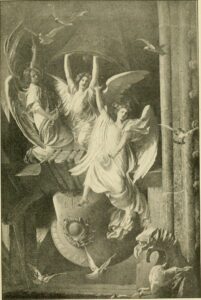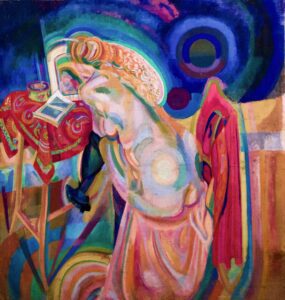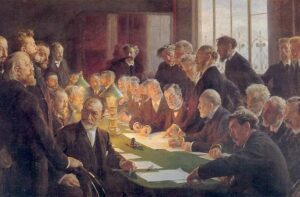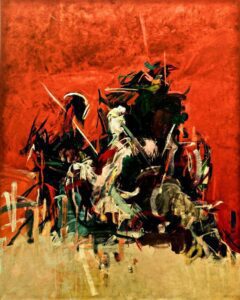The Independent Group in art shattered conventional boundaries and paved the way for modern pop culture.
Formed in the 1950s, they were a radical collective of young artists, writers, and architects who challenged the status quo.
We’ll jump into how their innovative approach to art, embracing mass media and consumerism, revolutionized the art world.
Stay tuned as we explore the groundbreaking impact of the Independent Group on contemporary art and culture.
Origins Of The Independent Group
The seeds of the Independent Group were sown post-World War II, a period ripe with social and technological transformation.
Amidst the ruins of the old world, a new cultural landscape was emerging, marked by the rapid spread of mass media and consumer culture.
The birthplace of this pivotal movement was the Institute of Contemporary Arts in London, where in 1952, the first formal meetings would chart the course of modern art.
Young visionaries, disenchanted with the insular nature of the art world, gathered to foster a discussion that would break the mold.
They rejected the highbrow elitism that art had come to symbolize, propelling themselves toward a future where art intersected with everyday life.
Their ethos resonated with the pop culture that was infiltrating society, and their ideas would soon ripple across oceans to influence generations.
Amid the creative ferment, Eduardo Paolozzi presented a groundbreaking lecture titled Bunk.
This collection of collages fashioned from American magazines created a shockwave among the attendees, heralding the blurring lines between art and advertisement.
Paolozzi, alongside architects like Alison and Peter Smithson, painter Richard Hamilton, and critic Lawrence Alloway, would become key figures steering the group’s innovative direction.
Our focus on the filmic perspective allows us to explore how the Independent Group’s fascination with popular culture extended into the cinematic realm.
They recognized film’s pivotal role in shaping public consciousness and its potential to democratize art by making it accessible to a wider audience.
This cross-pollination of art forms brought about a synergistic effect:
- The Group examined Hollywood’s influence,
- They explored the relationship between film aesthetics and consumer desires,
- They considered cinema as a tool for social commentary.
The ripple effect of the Independent Group’s influence is undeniable, ushering in an era where the boundaries of art were not just expanded but wholly redefined.
The members of the Independent Group were not merely observers of their time.
They were active participants, reshaping and redefining art’s relevance in a rapidly evolving world.
Their collaboration proved that through the unity of diverse disciplines, we discover the richness and vibrancy of creative expression.
Exploring The Radical Approach To Art
During post-war Britain, the Independent Group sought to dismantle longstanding art traditions.
They envisioned art as an accessible language that could bridge the gap between high culture and the burgeoning consumer society.
This vision led to a radical approach to art that actively engaged with the world around it, rather than existing in an elite vacuum.
The group’s innovative strategy was to merge fine art with mass culture, pioneering what would come to be known as Pop Art.
They heralded a new era where everyday objects – from advertisements to comic strips – warranted artistic scrutiny and reinterpretation.
The Independent Group’s exhibitions, such as This is Tomorrow at the Whitechapel Gallery in 1956, became beacons of this transformative movement.
Their approach was multi-disciplinary and collaborative, reflecting a diverse range of influences:
- Science and technology,
- Film and television,
- Architecture and urban planning,
- American pop culture.
A pivotal moment came with Richard Hamilton’s Just what is it that makes today’s homes so different, so appealing?
This collage epitomized the group’s ethos, blending mundane domesticity with the allure of consumerism.
By juxtaposing imagery from various sources, Hamilton crafted a compelling narrative that still resonates with viewers today.
Through their films, they created a new visual language that resonated with the realities of contemporary life.
The fusion of fine art and film offered a fresh perspective, one that spoke to the sensory and immersive nature of the cinema.
For members of the Independent Group, film was not just entertainment but a critical tool for understanding and commenting on society.
Embracing Mass Media And Consumerism
The emergence of the Independent Group marked a pivotal era in art history where the iron curtain between high art and everyday culture was torn down.
We witnessed artists engage with the themes of mass media and consumerism through their works, challenging the traditional confines of the fine art world.
Icons of this movement, like Eduardo Paolozzi and Richard Hamilton, utilized the imagery from advertisements, magazines, and television to critique and celebrate consumer culture.
Members of the Independent Group became architects of a new aesthetic that was unapologetically rooted in the realities of post-war society.

Art became a reflection of the burgeoning consumer landscape, and those ensconced in the Independent Group wielded their creativity to explore the consequences of this new world.
They saw beauty in the mundane – a radical
The intersection of art with film and television offered a dynamic platform for the Independent Group to convey their messages.
Films, in particular, served as critical tools, with the group’s members often drawing inspiration from the cinematic approaches of Hollywood as well as European avant-garde directors.
It Always Rains on Sunday and We Are the Lambeth Boys are a testament to their filmic exploration, using the medium to dissect modern life and its intricacies.
Our study of the Independent Group unveils several key artworks that epitomize this synergy:
- I was a Rich Man’s Plaything by Eduardo Paolozzi showcases the fascination with comic book iconography and advertising.
- Richard Hamilton’s $he explores the commodification of female identity through a collage of popular culture images.
This embracement of mass media and consumerism steered the direction of modern art, illustrating that the cultural shifts of any era serve as fertile ground for artistic innovation.
The dialogue between art and life, as propagated by the Independent Group, remains a cornerstone in understanding the development of contemporary art.
Revolutionizing The Art World
The Independent Group trailblazed a path for new artistic expressions during a pivotal time in history.

Their approach was nothing short of revolutionary; it dismantled long-held precepts in art and ushered in an era where mass culture was not just fodder but also a key material for creation.
We consider their impact monumental – they didn’t merely paint or sculpt; they fused artistic practice with the energy of popular culture.
Through their embrace of contemporary life, they delivered astute commentaries within their compositions.
Just what is it that makes today’s homes so different, so appealing?
by Richard Hamilton shrewdly questions the allure of modern living.
Their influence extended well beyond the canvas and gallery walls –
- laying the groundwork for the rise of Pop Art – altering public perception of what could be considered ‘fine’ art,
- fostering a dialogue between traditional mediums and new technology.
We recognize that the Independent Group’s flirtation with commercialism was in itself a bold move.
It challenged the elite boundaries of art and advocated for a more inclusive circle that encompassed film, design, and even architecture.
I was a Rich Man’s Plaything exemplifies this integration, featuring comic book elements that later became synonymous with Pop Art aesthetics.
Moving into the sphere of motion pictures, they drew from Hollywood’s glamor and European avant-garde techniques.
They were not just spectators but active participants in utilizing film as a critical tool.
Their critiques and observations of society reflected our changing world and the advancement of consumerism.
Their efforts reshaped how we perceive art within a social and cultural context.
It’s evident that the Independent Group was instrumental in shaping not only modern art but also the way we engage with media as a form of artistic discourse.
They set a precedent – art could be both a mirror and a hammer, reflecting society and shaping it simultaneously.
The Impact On Contemporary Art And Culture
The Independent Group’s influence extends far beyond their 1950s origins, leaving an indelible mark on contemporary art and culture.
Their pioneering approach dismantled barriers – art became a conversation with the audience, provoking thought and stimulating dialogue.

Artists now routinely blur the lines between high and low culture, echoing their groundbreaking methods.
Their bold integration of materials from everyday life into artworks offered fresh perspectives and created a new visual language for artists.
From this, movements such as Pop art emerged, taking cues from the Independent Group’s fascination with consumer culture.
The likes of Andy Warhol and Roy Lichtenstein embraced this ethos, catapulting mundane objects into the spotlight through their work.
Enhancing Interdisciplinary Collaboration
Interdisciplinary practices that we witness today can trace roots back to the collaborative spirit of the Independent Group.
They modeled the fusion of various disciplines – from fine art to advertising – which has become a crucial approach in contemporary creative industries.
Current artists and creatives often work across multiple media, emphasizing the need for:
- Broad skill sets,
- Innovative thinking,
- Cross-pollination of ideas.
Their interdisciplinary approach has significantly influenced educational paradigms within art schools, encouraging a holistic learning experience that transcends traditional mediums.
Pioneering New Technology Use In Art
The Independent Group’s forward-thinking application of technology in art anticipated the digital revolution and the Internet’s role in art dissemination.
They were amongst the first to explore how film could act as both a medium and a message, predicting the centrality of visual media in contemporary culture.
Today’s new media artists owe a debt to their pioneering use of multimedia, which has inspired innovative ways to engage audiences through digital platforms.
By recognizing the significance of the Independent Group in the evolution of modern art practices, we can appreciate their lasting contributions to art’s continued dialogue with society.

Their legacy informs and enriches our understanding of how art intersects with daily life, shaping culture across the decades.
What Is Independent Group In Art – Wrap Up
We’ve seen how the Independent Group’s innovative spirit forever altered the art landscape.
Their bold fusion of art with popular culture and technology set the stage for future generations to explore and redefine.
Today we recognize their pivotal role in shaping modern art and cultural discourse.
As we reflect on their enduring influence it’s clear they didn’t just reflect the zeitgeist—they were the catalyst for a new era of artistic expression.
Their legacy lives on inspiring artists and creatives to push boundaries and challenge the status quo.
Frequently Asked Questions
Who Were The Independent Group?
The Independent Group was a collective of artists, writers, and architects active in the 1950s who challenged traditional art by integrating popular culture and consumerism, paving the way for Pop Art.
How Did The Independent Group Change The Art World?
The Independent Group revolutionized the art world by embracing mass culture, expanding beyond traditional art forms to include film, design, and architecture, and fostering a dialogue between different mediums and new technologies.
What Was The Role Of Film In The Independent Group’s Work?
Film played a critical role in the Independent Group’s work as a tool for commentary on societal changes and the advancement of consumerism, often used to reflect and critique cultural dynamics.
How Did The Independent Group Influence Modern Art And Culture?
The Independent Group left a profound impact on modern art and culture by dismantling the barriers between high and low culture, inspiring the development of Pop Art, and influencing the collaborative and interdisciplinary approaches prevalent in today’s creative industries.
What Did The Independent Group Anticipate About The Future Of Art?
The Independent Group anticipated the digital revolution and the importance of the Internet in the dissemination of art, inspiring new media artists to utilize digital platforms to engage with audiences.


